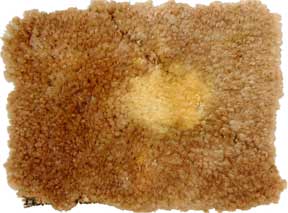BLEACHES and CARPET What is bleach and how is it used?Most people, when they hear the word “bleach” automatically visualize a gallon jug of Clorox® chlorine bleach. My dictionary says that bleach is anything that removes color. There are actually two primary ways of removing color - oxidizing and reducing. An oxidizing bleach is a chemical that gains electrons and causes the oxidation of another substance. That is, an oxidizing bleach removes color by adding oxygen (or chlorine) to a dye structure, or even destroys the dye molecule by splitting it apart. The ultimate form of oxidation is burning - where the substance is totally destroyed by high temperatures and oxygen! Examples of oxidizing bleaches are hydrogen peroxide, chlorine bleach (sodium hypochlorite), sodium perborate, sodium persulfate and sodium percarbonate. Even ozone and medications such as some acne medicines containing benzoyl peroxide are oxidizing bleaches. Stain 1 Stain Remover and the two-part Stain Magic® also contain hydrogen peroxide oxidizing bleach as one of its components. Hydrogen peroxide is a clear, self-neutralizing, unstable oxidizing bleach that should be stored in a dark, cool place, in a dark colored bottle and kept no more than 6 months. When using hydrogen peroxide, such as whitening grayed rug fringes, start with the 3% strength found in most drug stores. Do not leave on stain more than 30 minutes and follow with wet extraction to ensure complete removal to prevent residual bleaching. In some cases, 3% hydrogen peroxide can be left on the stain on nylon carpet overnight without rinsing, but some risk is involved. Hydrogen peroxide oxidation can be accelerated by an alkali (pH over 7), by heat (very risky) or simply by sunlight. Hydrogen peroxide simply breaks down to water and oxygen as it dries, leaving no residue. Pretest in an inconspicuous area for bleaching or discoloration of the carpet or rug dyes. Get a signed release because the carpet dyes may be irreversibly bleached out or changed. Attempt only on light colors. Use on wool VERY carefully. 3% hydrogen peroxide is excellent for whitening cotton fringes on oriental design rugs. The 40-volume clear hydrogen peroxide from the beauty supply house (usually labeled “40 Volume Clear Developer”) is 12% strength. The 30% hydrogen peroxide from chemical suppliers is 100 volume. “Volume” is not the same as “per-cent”! Oxidizing bleaches are excellent against stains from mildew, furniture, ink, coffee, cellulosic browning, urine and feces. Chlorine bleach should only be used on solution dyed fibers. On 100% olefin carpet, it may be used undiluted, but should be rinsed out after use. On solution dyed nylon, it should be diluted to at least 1 part bleach to 4 parts water before use. Chlorine bleach will damage even solution-dyed nylon fibers and should only be used when nothing else works! ALWAYS extract out chlorine bleach after use. Be sure there is no bleach on your shoes, hoses, etc. where it might get on other carpet or furniture. NEVER mix chlorine bleach with any other chemicals. Household chlorine bleach is about 5.25% sodium hypochlorite with a pH of about 12! Chlorine bleach, even dry, can still be reactivated with water and its residue is caustic soda. Chlorine bleach dissolves wool and severely weakens cotton. NEVER bring a bottle of chlorine bleach into a house! A reducing bleach is a chemical that loses electrons and removes oxygen from a compound. Reducing bleaches are sometimes called strippers or stripping agents. Examples of reducing bleaches are sodium thiosulfate (photographer’s hypo), titanium stripper, sodium bisulfite and sodium hydrosulfite. Rit® Color Remover, Streepene®, CloroX Bleach Neutralizer, Red 1® Stain Remover and the two-part product Red Relief® contain reducing bleaches. Sodium bisulfite is a weak reducing bleach; sodium hydrosulfite is a very strong reducing bleach. Sodium bisulfite is a common ingredient in Haitian cotton shampoos. Reducing bleaches are accelerated by heat and by acid. Reducing bleaches are especially effective against grape juice, Kool-Aid®, wine, iodine and Betadine®. Reducing bleaches also act as “anti-chlors” - neutralizing oxidizing bleaches such as chlorine bleach. CloroX Bleach Neutralize by Pro's Choice is an anti-chlor formulated to neutralize chlorine bleach on carpet. To use Rit Color Remover, dissolve 2 ounces of the reducing bleach in VERY hot water, cover the stain with a white turkish towel, pour the solution on the towel, remove the towel after about 10 minutes, thoroughly extract and dry blot. Repeat if needed. Rit Color Remover is commonly sold in discount stores in the laundry area. Its primary active ingredient is sodium hydrosulfite. NOTE: Because this is a powder, protect it from moisture and spills. Of course, Red Relief and Red 1 are more powerful. The biggest drawback to reducing bleaches is that the oxygen in air alone may re-oxidize the stain and it will reappear - after all, the stain was simply made colorless, not actually removed or destroyed! Related Spotting Information and Articles:
Related Spot and Stain Removal Videos:
Related Spot and Stain Removal Products (Links Open to the Bane-Clene Store in Separate Windows):
NOTE: This article is a revised version of an article that originally appeared in the May/June 2000 Bane-Clene Cleaning Digest®. Free Bane-Clene Information Package
You can also order the packet at the Catalog Request Form.
|
 Free packet of information about Bane-Clene can be obtained by calling toll-free 1-800-428-9512 (U.S. ONLY!). Your information packet will include a full color catalog and price addendum. Packets will arrive in approximately 2 weeks through standard United States Mail.
Free packet of information about Bane-Clene can be obtained by calling toll-free 1-800-428-9512 (U.S. ONLY!). Your information packet will include a full color catalog and price addendum. Packets will arrive in approximately 2 weeks through standard United States Mail. “A to Z” Alphabetical Index to the Bane-Clene Web Site
“A to Z” Alphabetical Index to the Bane-Clene Web Site Bane-Clene Home Page
Bane-Clene Home Page
